Themed collection FOCUS: Light-emitting diodes technology

Recent advances in highly-efficient near infrared OLED emitters
This work describes recent developments in near-infrared (NIR) organic light-emitting diode (OLED) emitters. We discuss applications of NIR OLEDs as well as various groups of highly luminescent materials used in the OLED emissive layer.

Mater. Chem. Front., 2024,8, 1731-1766
https://doi.org/10.1039/D3QM01067H
Acceptor–donor–acceptor based thermally activated delayed fluorescent materials: structure–property insights and electroluminescence performances
Thermally activated delayed fluorescent (TADF) materials shown great attention in Organic light-emitting diodes (OLEDs). Herein, we have systematically reviewed the Acceptor–Donor–Acceptor based TADF materials with electroluminescent characteristics.
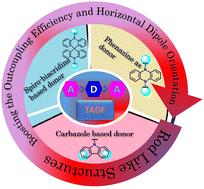
Mater. Chem. Front., 2024,8, 769-784
https://doi.org/10.1039/D3QM01125A
Transition metal ion-doped cesium lead halide perovskite nanocrystals: doping strategies and luminescence design
We herein briefly review the recent advances in transition metal ion-doped cesium lead halide perovskite nanocrystals including the typical strategies for effective doping and optical properties manipulation.
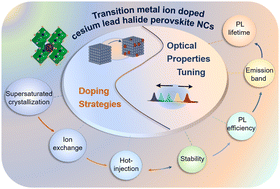
Mater. Chem. Front., 2024,8, 192-209
https://doi.org/10.1039/D3QM00691C
Cross-linking strategies for hole transport/emissive layers in quantum-dot light-emitting diodes
To avoid the interlayer erosion challenge in the IJP process and direct patterning process of the QD emissive layer (EML), cross-linking strategies have been introduced to construct solvent-resistant films (hole transport layers or QD EMLs) upon exposure to heat or light.

Mater. Chem. Front., 2023,7, 6130-6140
https://doi.org/10.1039/D3QM00831B
Recent advances in regulating the excited states of conjugated thermally activated delayed fluorescence polymers for high-efficiency OLEDs
Several methods are summarized for controlling the excited states of TADF conjugated polymers, covering: (a) maintaining suitable ΔEST; (b) localized triplet excited state assisted reverse intersystem crossing; (c) hyperfine coupling facilitates reverse intersystem crossing.

Mater. Chem. Front., 2023,7, 6141-6153
https://doi.org/10.1039/D3QM00799E
Near-infrared organic light-emitting materials, devices and applications
In this article, we overview the latest advancements in organic near-infrared (NIR) materials, light-emitting devices and their applications. Moreover, we discuss the current limitations and future prospects for the NIR technology.
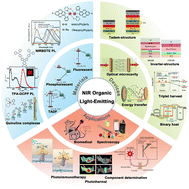
Mater. Chem. Front., 2023,7, 4744-4767
https://doi.org/10.1039/D3QM00585B
A review of fused-ring carbazole derivatives as emitter and/or host materials in organic light emitting diode (OLED) applications
This review focuses on fused-ring carbazole derivatives, their molecular design, electronic and photophysical properties, and their applications as the emitter and/or the host material in organic light emitting diodes (OLEDs).

Mater. Chem. Front., 2023,7, 4304-4338
https://doi.org/10.1039/D3QM00399J
Recent advances and prospects for organoboron-based thermally activated delayed fluorescence emitters
The recent research progress of organic boron-containing thermally activated delayed fluorescence (TADF) materials is reviewed systematically with a focus on the molecular design, photophysical properties and performance of the corresponding OLEDs.

Mater. Chem. Front., 2023,7, 4420-4444
https://doi.org/10.1039/D3QM00498H
Construction of organic micro/nanocrystal lasers: from molecules to devices
To summarize the achievements of organic micro/nanocrystals in the field of solid-state lasers, we herein briefly review their recent progress from the perspective of organic molecules, morphology modulation, laser applications in photonic devices.

Mater. Chem. Front., 2023,7, 3922-3936
https://doi.org/10.1039/D3QM00461A
Light outcoupling strategies in oriented perovskite light-emitting-diodes: recent trends, opportunities, and challenges toward innovation
The engineering of the refractive index, transition dipole moments, the integration of photonic structures, and the photon-recycling process are the representative strategies to improve the outcoupling in perovskite light-emitting diodes (PeLEDs).

Mater. Chem. Front., 2023,7, 2316-2336
https://doi.org/10.1039/D2QM01365G
Sensitized organic light-emitting diodes: towards high efficiency and long lifetimes
This review summarizes the mechanisms and development of sensitized OLEDs, with phosphorescent, TADF, and exciplex materials as sensitizers.

Mater. Chem. Front., 2023,7, 1760-1780
https://doi.org/10.1039/D2QM01379G
Solution-processed OLEDs for printing displays
Recent advances in solution-processed organic light-emitting diodes toward printing displays are reviewed in terms of light-emitting materials, devices, printing techniques and applications.

Mater. Chem. Front., 2023,7, 1166-1196
https://doi.org/10.1039/D2QM01241C
Synthesis and structure design of I–III–VI quantum dots for white light-emitting diodes
The synthesis and structural design of I–III–VI quantum dots are summarized and WLED applications are highlighted. The routes to improve the performance of WLED devices and the challenges of design optimization and practical application are discussed.

Mater. Chem. Front., 2022,6, 418-429
https://doi.org/10.1039/D1QM01452H
Design of Cr3+-activated broadband NIR phosphors with tunable and abnormal thermal quenching behavior for NIR pc-LEDs
The decreased energy difference between 4T2 and 2E states leads to tunable and abnormal thermal quenching performance of Lu3−xCaxGa5−xSixO12:Cr3+ phosphors.

Mater. Chem. Front., 2024,8, 2874-2881
https://doi.org/10.1039/D4QM00395K
Unsymmetrical substituted steric terfluorenes for solution-processed narrowband deep-blue organic light-emitting diodes with CIEy = 0.06
Multiple-site functionalization of fluorene-based molecules can not only obtain robust deep-blue electroluminescent behavior but also enhance the film-forming ability to manufacture large-area film via solution processing technology.

Mater. Chem. Front., 2024,8, 2859-2865
https://doi.org/10.1039/D4QM00332B
Intrinsically stretchable and efficient cross-linked small molecular emitter for flexible organic light-emitting diodes
Due to their rigid and plane conjugated skeletons, small molecular semiconductors always present irreversible brittle properties in the nano-film state, which is not conducive to deformation and operation stability in flexible optoelectronic devices.

Mater. Chem. Front., 2024,8, 1950-1957
https://doi.org/10.1039/D3QM01349A
Solvent-free synthesis of stable heterostructured-CsPbBr3/Cs2PbBr5 assisted by SiO2 for white light-emitting diodes
We developed a facile synthesis for preparation of stable CsPbBr3/Cs2PbBr5 heterostructures at room temperature, which could be used to scale up production of perovskite phosphors without compromising their performance. This process used SiO2 nanospheres to avoid using hazardous organic solvents.
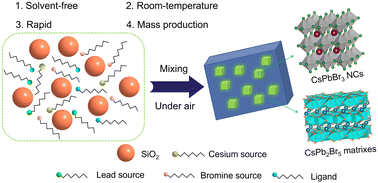
Mater. Chem. Front., 2024,8, 1628-1635
https://doi.org/10.1039/D3QM01233F
Multiplying the electroluminescence efficiencies of red TADF emitters via a regioisomeric approach of the donor unit
Constructing regioisomeric red TADF emitters via managing donor connecting patterns. A DPDPZ-PXZPh-based OLED affords an improved EQE of 28.0%, peaking at 600 nm.

Mater. Chem. Front., 2024,8, 1120-1127
https://doi.org/10.1039/D3QM01170D
TADF emitters based on a tri-spiral acridine donor and a spiro-B-heterotriangulene acceptor with high horizontal dipole orientation ratios and high efficiencies in deep-blue OLEDs
Linearly expanded rigid TADF emitters, composed of a tri-spiral acridine donor and a spiro-fluorenyl-B-heterotriangulene acceptor, exhibit very high horizontal dipole orientation ratios, thereby achieving high efficiencies in deep-blue OLEDs.

Mater. Chem. Front., 2023,7, 5413-5421
https://doi.org/10.1039/D3QM00653K
Deep-red/NIR AIEgens based on electron-withdrawing dithiafulvalene-fused benzothiadiazole for solution-processed non-doped OLEDs
Deep-red (DR)/near-infrared (NIR) emitters have extensive applications in bioimaging and flexible optoelectronics.

Mater. Chem. Front., 2023,7, 5431-5438
https://doi.org/10.1039/D3QM00598D
Efficient narrow green organic light-emitting diodes with low efficiency roll-offs based on iridium(III) complexes containing indolo[3,2,1-jk]carbazole and pyrimidine units
Two green Ir(III) complexes based on the ligands containing indolo[3,2,1-jk]carbazole and pyrimidine units show high PLQYs and small FWHMs. The OLEDs show good performances with an EQEmax of 31.3% and extremely low efficiency roll-offs.
![Graphical abstract: Efficient narrow green organic light-emitting diodes with low efficiency roll-offs based on iridium(iii) complexes containing indolo[3,2,1-jk]carbazole and pyrimidine units](/en/Image/Get?imageInfo.ImageType=GA&imageInfo.ImageIdentifier.ManuscriptID=D3QM00514C&imageInfo.ImageIdentifier.Year=2023)
Mater. Chem. Front., 2023,7, 4944-4951
https://doi.org/10.1039/D3QM00514C
Suppression and utilization of Kasha's rule: realizing the transformation from blue to near-infrared emission
Phenoxazine–phenazine exhibits variable emission by suppressing and utilizing Kasha's rule and demonstrates both dual emission and near-infrared emission. This significant mechanism related to Kasha's rule would be advantageous in various fields.

Mater. Chem. Front., 2023,7, 4092-4099
https://doi.org/10.1039/D3QM00394A
Achieving high color purity in multi-resonance thermally activated delayed fluorescence emitters through a substitution-driven design strategy
The origin of the reorganization energy can be elucidated from the perspective of molecular orbital (MO). Furthermore, the reorganization energy variations can be rationalized by MO distribution.

Mater. Chem. Front., 2023,7, 3762-3773
https://doi.org/10.1039/D3QM00280B
Peripheral engineering of platinum(II) dicarbene pincer complexes for efficient blue hyperphosphorescent organic light-emitting diodes
Pt(II) dicarbene pincer complexes served as a promising dopant sensitizer to an MR-TADF terminal emitter.

Mater. Chem. Front., 2023,7, 3398-3405
https://doi.org/10.1039/D3QM00273J
Hole-transport-layer-free CdSe/ZnS core/shell red quantum-dot light-emitting diodes sensitized by TADF polymers
Energy transfer and charge transport in the thermally activated delayed fluorescence polymer doped quantum-dots were investigated. A high EQE of 18.1% was demonstrated for the first time in the quantum-dot red LEDs without any hole transport layers.

Mater. Chem. Front., 2023,7, 2839-2843
https://doi.org/10.1039/D3QM00130J
Panchromatic luminescent D–π–A benzothiazoles with different π-bridging modulation: design, synthesis and application in WLED devices
White light-emitting diodes (WLEDs) are gradually replacing traditional lighting devices and are becoming a mainstream photosource, as they have advantages of low energy consumption and high efficiency.

Mater. Chem. Front., 2023,7, 2860-2870
https://doi.org/10.1039/D3QM00189J
Red-shift emission and rapid up-conversion of B,N-containing electroluminescent materials via tuning intramolecular charge transfer
The introduction of different donors at the para-carbon position of the BNCz core modulates the predominance of locally excited (LE)/charger transfer (CT) states of the TADF materials to achieve full-color emission.

Mater. Chem. Front., 2023,7, 2454-2463
https://doi.org/10.1039/D3QM00131H
Blue emitters with various electron-donors attached to the 9-phenyl-9-phosphafluorene oxide (PhFIOP) moiety and their thermally activated delayed fluorescence (TADF) behavior
Blue emitters with various electron-donors attached to the 9-phenyl-9-phosphafluorene oxide (PhFIOP) moiety and their thermally activated delayed fluorescence (TADF) behavior.

Mater. Chem. Front., 2023,7, 1841-1854
https://doi.org/10.1039/D2QM01339H
Efficient thermally activated delayed fluorescence emitters with regioisomeric effects for red/near-infrared organic light-emitting diodes
The regioisomeric effect of cyano substituents on the photoluminescence and electroluminescence properties of thermally activated delayed fluorescence molecules is studied.

Mater. Chem. Front., 2023,7, 1633-1641
https://doi.org/10.1039/D3QM00051F
Highly efficient white organic light-emitting diodes based on balanced bipolar-transporting blue hybridized local charge transfer fluorophores
A super-efficient hybrid WOLED was achieved by blending the HLCT-based blue fluorescent molecule (TPACFOXZ) with a yellow phosphorescent molecule.

Mater. Chem. Front., 2023,7, 1403-1410
https://doi.org/10.1039/D3QM00013C
Efficient narrowband green OLEDs with TADF sensitizers combining multiple charge-transfer pathways
Benefitting from the concurrent intramolecular TBCT and TSCT of ortho-linked TADF materials, high kF and kRISC are achieved simultaneously and the devices using o-DCz-TRZ and BN-DMAc as emitters achieved high EQEs of 20.3% and 24.2%.

Mater. Chem. Front., 2023,7, 1128-1136
https://doi.org/10.1039/D2QM01363K
High-efficiency and stable red to near-infrared organic light-emitting diodes using dinuclear platinum(II) complexes
High-performance red and NIR organic light-emitting diodes (OLEDs) have been achieved using highly robust and phosphorescent diplatinum(II) complexes featuring strong intramolecular Pt–Pt and π–π interactions.
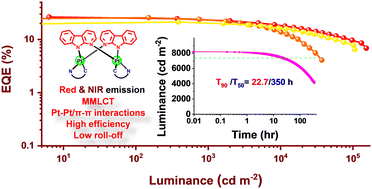
Mater. Chem. Front., 2023,7, 873-880
https://doi.org/10.1039/D2QM01163H
Solution-processed triphenylethylene-fluorene fluorochromes toward deep-blue organic light-emitting diodes: benefits of preventing radical formation
High band exciton is easily trapped and quenched by the defect structure in wide bandgap light-emitting conjugated materials (LCMs), which is harmful to the performance and stability of deep-blue organic light-emitting diodes (OLEDs).

Mater. Chem. Front., 2023,7, 267-273
https://doi.org/10.1039/D2QM01053D
Strongly polarized surface electroluminescence from an organic light-emitting transistor
Highly emissive organic semiconductor that supports the combination of balanced ambipolar charge transport, weakened light waveguiding, and strongly polarized surface electroluminescence in organic light-emitting transistors is reported.

Mater. Chem. Front., 2023,7, 238-248
https://doi.org/10.1039/D2QM01046A
Regulation of excited-state properties of dibenzothiophene-based fluorophores for realizing efficient deep-blue and HLCT-sensitized OLEDs
High external quantum efficiencies of 7.08% and 27.30% and low efficiency roll-off are achieved simultaneously based on HLCT-sensitized fluorescent and phosphorescent OLEDs.

Mater. Chem. Front., 2023,7, 85-95
https://doi.org/10.1039/D2QM01008A
Colloidal synthesis of size-confined CsAgCl2 nanocrystals: implications for electroluminescence applications
A facile EuCl3-based route to CsAgCl2 nanocrystals with tunable particle size was proposed. LEDs fabricated exhibit favorable warm white-light emission, which opens up new avenues to develop single-component warm white LEDs.

Mater. Chem. Front., 2022,6, 3669-3677
https://doi.org/10.1039/D2QM00997H
Thermally activated delayed fluorescence dendrimers achieving 20% external quantum efficiency for solution-processed OLEDs
TADF dendrimers with a D–A–D structure, with multi-carbazole as the donor and di(pyridine-3-yl)methanone as the acceptor, are synthesized and their solution-processed OLEDs achieved a CEmax of 52.6 vs. 27.0 cd A−1 and an EQEmax of 20.4% vs. 9.2%.

Mater. Chem. Front., 2022,6, 3442-3449
https://doi.org/10.1039/D2QM00833E
Highly efficient thermally activated delayed fluorescence emitter based on the 5H-benzo[d]benzo[4,5]imidazo[1,2-a]imidazole donor
A donor–π-acceptor-type TADF emitter (BzITz) was designed and synthesized using 5H-benzo[d]benzo[4,5]imidazo[1,2-a]imidazole as a fused rigid electron donor and a benzonitrile merged triazine unit as an electron acceptor.
![Graphical abstract: Highly efficient thermally activated delayed fluorescence emitter based on the 5H-benzo[d]benzo[4,5]imidazo[1,2-a]imidazole donor](/en/Image/Get?imageInfo.ImageType=GA&imageInfo.ImageIdentifier.ManuscriptID=D2QM00806H&imageInfo.ImageIdentifier.Year=2022)
Mater. Chem. Front., 2022,6, 3382-3390
https://doi.org/10.1039/D2QM00806H
An efficient solution-processable non-doped hybridized local and charge-transfer (HLCT) emitter for a simplified organic light-emitting diode
A solution-processable HLCT fluorescent molecule realizes a highly efficient non-doped OLED with a high brightness of 30 800 cd m−2, a maximum external quantum efficiency (EQEmax) of 6.74% and a maximum current efficiency (CEmax) of 14.38 cd A−1.

Mater. Chem. Front., 2022,6, 3225-3236
https://doi.org/10.1039/D2QM00401A
Achievement of high efficiency and thermally stable near-infrared phosphors by designing a chromium crystallographic environment for nondestructive testing and night vision
XTaO4:Cr3+ presents a high internal/external quantum efficiency and good thermal stability.

Mater. Chem. Front., 2022,6, 2741-2749
https://doi.org/10.1039/D2QM00569G
Copper-incorporation for polytypism and bandgap engineering of MAPbBr3 perovskite thin films with enhanced near-Infrared photocurrent-response
Formation of secondary phase polytypes through incorporation of copper into MAPbBr3 perovskite yields bandgap reduction with generation of near-IR photocarriers.

Mater. Chem. Front., 2022,6, 2690-2702
https://doi.org/10.1039/D2QM00491G
A large-scale deep-blue tetraphenylbenzene-bridged hybridized local and charge transfer fluorophore exhibiting small efficiency roll-off and low amplified spontaneous emission threshold
A deep-blue HLCT emitter PTPC achieved a high EQE of 6.78% in a non-doped OLED as well as a low ASE threshold of 1.18 μJ cm−2.

Mater. Chem. Front., 2022,6, 2085-2094
https://doi.org/10.1039/D2QM00506A
Purely organic phosphor sensitization for efficiency improvement in yellow fluorescent organic light-emitting diodes
Utilization of a purely organic based room-temperature phosphorescent (RTPH) emitter as a sensitizer was studied by employing it in yellow fluorescent organic light-emitting diodes (OLEDs).

Mater. Chem. Front., 2022,6, 1982-1988
https://doi.org/10.1039/D2QM00282E
Spiro-configured dibenzosuberene compounds as deep-blue emitters for organic light-emitting diodes with a CIEy of 0.04
Deep blue electroluminescence is highly required for organic light-emitting diode (OLED) technology. We report, in this work, blue emitting fluorophores for OLED with low CIEy.
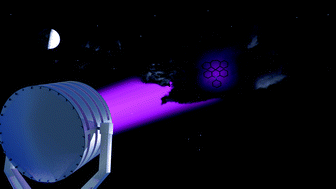
Mater. Chem. Front., 2022,6, 1803-1813
https://doi.org/10.1039/D2QM00287F
Highly emissive and color-tunable copper-based halide composites for bright white light-emitting diodes
The blue-emissive Cs3Cu2I5, yellow-emissive CsCu2I3, and white-emissive Cs3Cu2I5@CsCu2I3 composites have been obtained by a one-step microwave method. The three UV-pumped WLEDs are fabricated by using the composites, and a CRI of 92 is achieved.
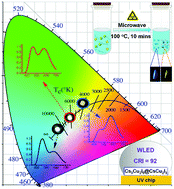
Mater. Chem. Front., 2022,6, 1647-1657
https://doi.org/10.1039/D2QM00172A
Efficient red organic LEDs via the combination of an exciplex host and micro-cavity
We report a current efficiency of 99.7 cd A−1 for a red OLED with an electroluminescence (EL) peak at 604 nm (full width at half maximum of 32 nm).
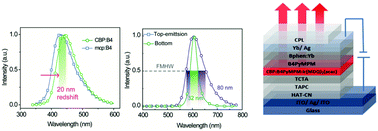
Mater. Chem. Front., 2022,6, 1623-1629
https://doi.org/10.1039/D2QM00203E
Isomeric thermally activated delayed fluorescence emitters based on a quinolino[3,2,1-de]acridine-5,9-dione multiple resonance core and carbazole substituent
The color purity of the pixels is an essential indicator in organic light-emitting diode (OLED) commercial displays.
![Graphical abstract: Isomeric thermally activated delayed fluorescence emitters based on a quinolino[3,2,1-de]acridine-5,9-dione multiple resonance core and carbazole substituent](/en/Image/Get?imageInfo.ImageType=GA&imageInfo.ImageIdentifier.ManuscriptID=D1QM01588E&imageInfo.ImageIdentifier.Year=2022)
Mater. Chem. Front., 2022,6, 966-972
https://doi.org/10.1039/D1QM01588E
New aggregation-induced delayed fluorescent materials for efficient OLEDs with high stabilities of emission color and efficiency
New aggregation-induced delayed fluorescence luminogens are developed, which exhibit high electroluminescence efficiencies, very small efficiency roll-offs and high emission color stability.

Mater. Chem. Front., 2022,6, 924-932
https://doi.org/10.1039/D1QM01625C
A meta-linkage strategy towards high-performance hosts for efficient blue thermally activated delayed fluorescence OLEDs
The development of high-performance host materials for blue thermally activated delayed fluorescence (TADF) emitters is crucial for realizing efficient blue organic light-emitting diodes (OLEDs).
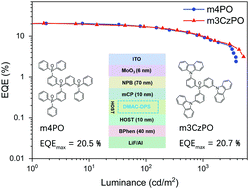
Mater. Chem. Front., 2022,6, 748-756
https://doi.org/10.1039/D1QM01660A
Spirobifluorene modified electron transport materials for high efficiency in phosphorescent organic light-emitting diodes
Spirobifluorene modified materials developed as electron transport layers lowered device driving voltage, enhanced quantum efficiency, and more than doubled the lifetime of green phosphorescent organic light-emitting diodes.

Mater. Chem. Front., 2022,6, 757-764
https://doi.org/10.1039/D1QM01610E
Synthesis of broadband NIR garnet phosphor Ca4ZrGe3O12: Cr3+, Yb3+ for NIR pc-LED applications
The emission mechanism and origin of the host and Cr3+/Yb3+ co-doped Ca4ZrGe3O12.

Mater. Chem. Front., 2022,6, 440-449
https://doi.org/10.1039/D1QM01540K
High-performance perovskite light-emitting diodes based on grain boundary passivation: progress, challenges and perspectives
Metal halide perovskites are emerging as promising candidates for next-generation display and lighting technologies.

Mater. Chem. Front., 2023,7, 5466-5474
https://doi.org/10.1039/D3QM00853C
Making coordination networks ionic: a unique strategy to achieve solution-processable hybrid semiconductors
Recent advancements in solution-processable AIO hybrid semiconductors. The formation of ionic and coordinate bonds at the organic/inorganic interface leads to desirable properties for the fabrication of thin-film based optoelectronic devices.

Mater. Chem. Front., 2023,7, 4598-4604
https://doi.org/10.1039/D3QM00515A
Are pure hydrocarbons the future of host materials for blue phosphorescent organic light-emitting diodes?
This Chemistry Frontiers deals with a new generation of host materials for phosphorescent OLEDs only constituted with carbon and hydrogen atoms, which can be beneficial for the future development of the OLED industry.

Mater. Chem. Front., 2022,6, 1246-1252
https://doi.org/10.1039/D2QM00083K
About this collection
Materials Chemistry Frontiers is delighted to introduce you the following collection of articles on “Light-emitting diodes technology”. Articles featured in our focus collections are handpicked by Editors. We hope you find them enjoyable to read. Access is free till September 25th, 2024.